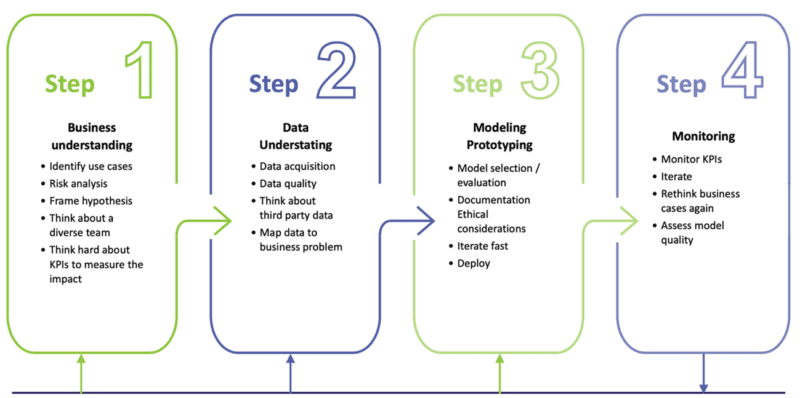The following blog post was written by Michael Hausmann as part of the certificate thesis “Implementation of AI in the SME environment” in the CAS course AI Management and contains subjective colorations.
Today, small and medium-sized enterprises in particular are faced with the challenge of using artificial intelligence (AI) methods to increase value creation. In the past, the implementation and also the operation of AI were not profitable enough. What’s the situation today?
Every Beginning Is Hard
It is particularly difficult for SMEs to get started with artificial intelligence. The multitude of AI-driven services and specialties makes it very difficult to choose, especially for people outside the field. Specialized professionals are scarce on the labor market and if someone is found, they are correspondingly expensive. For this reason, the shortage of specialists is cited as one of the greatest challenges in companies. Managing AI risks, data issues and lack of management commitment are also cited. The study conducted by Bitkom Research on the basis of a survey of 600 different companies in Germany is interesting.
According to this study, only 8 percent of the companies surveyed use artificial intelligence in their own operations. Among companies with up to 500 employees, around 23 companies would like to invest in a solution based on artificial intelligence in the next two years.
Useful Areas of Application In SMEs
Roughly 55 percent of companies with up to 500 employees that have never invested in AI will wonder where AI can even be used in their company. Below are two examples of possible use cases.
Customer contact:
Every day, companies receive inquiries via e-mail, telephone or other channels that take up a lot of time and resources to process. With the help of technologies from the field of artificial intelligence (“natural language processing”(NLP)), recurring business processes (e.g., support requests), can be better structured and thus processed faster. Such automation can significantly reduce the workload of a service desk and serve customers more quickly, thus generating clear added value.
Image processing:
Image processing, usually called “computer vision,” is another area of artificial intelligence. This is the name given to systems that recognize, analyze and process objects in digital still and moving image material. In SMEs, however, computer vision is most frequently used for recurring tasks, such as the automated filing of documents.
These are two examples where implementation can already have a direct impact on the company’s value creation. Depending on the application, the return on investment is estimated to be between one and two years.
How do I successfully implement an AI project?
Lack of data, no acceptance of the solution in the company, wrong expectations, no support from management – all these statements describe why more than 50% of all AI projects cannot be implemented successfully.
As part of my continuing education, I set myself the task of analyzing how the success rate in the implementation of AI projects, especially in the SME sector, can be increased. The choice for the approach fell on the AI project implementation in the four steps:
- Business Understanding
- Data Understanding
- Modelling Prototyping
- Monitoring

Figure: AI Implementation project in 4 stepsSource: HWZ. Dr. Marcel Blattner, Introductory lesson Artificial Intelligence
This proven method has already been used many times by larger companies. Therefore, my analysis and research were focused on making the project implementation “suitable for SMEs”. This was first carried out on a theoretical basis and then implemented in practice. The main findings are presented below:
If possible, the responsibility of the project should be transferred to a whole team and less burdened on individual persons. The wide range of competencies can hardly be covered by one person. AI projects are usually a small part of a larger project. It is also important to ensure that the people in the project have the skills and experience to implement the solution. Otherwise, there can be significant delays, which can even lead to the project being aborted.
The project team must be assigned various roles during implementation. In a large company, the following roles are required in each case for such projects:
- Business Owner (Step 1-4)
- Delivery Manager (Step 1-4)
- Analytics Translator (Step 1-4)
- Visualization Analyst (Step 2, Step 3)
- Data Scientist (Step 1 – 4)
- Data Analyst (Step 1-4)
- Data Engineer (Step 1-4)
- Machine Learning Engineer (Step 2-4)
- Data Strategist (Step 2-4)
- KI-Evangelist (Step 1-4)
An SME can hardly afford to hire so many specialists. In order to make the project implementation suitable for SMEs, it is unavoidable that project employees have to occupy several roles. Thanks to the structured procedure with the “project implementation in four steps”, the project could be implemented with three people in the practical application. Consequently, the procedure can definitely be described or recommended as suitable for SMEs.
A Streak Of Light On the Horizon?
Amazon, Google, Microsoft, IBM, but also companies like SAP are increasingly entering the market with Machine Learning as a Service solutions. This means that providers offer standardized AI solutions, which companies can rent and use for their own needs. Thus, the costs for the implementation and also the operation are affordable and attractive for SMEs.
In the near future, people from outside the industry will also be able to rent such AI services from providers. Ultimately, however, success is based on successful AI project implementation. Despite the new possibilities, core elements such as the risks, the AI strategy and much more have to be worked out during the implementation itself, at least for the time being.

